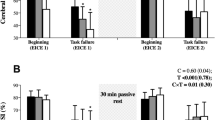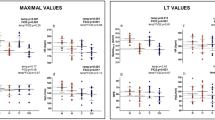Abstract
The study of the tolerability of a bicycle exercise test before and after normobaric hypoxic training (NHT) in different regimens was conducted to assess the influence of NHT on the state of the physical working capacity of healthy individuals. A biocybernetic approach allowing the assessment of the dynamics of the physiological variables during the performance of the load test was proposed for a detailed determination of the physiological cost of muscle activity. Hypoxic training was shown to significantly increase the tolerance of physical work, especially when more “strenuous” NHT regimes were used. The high information content of dynamic physiological criteria for assessing the physical working capacity was revealed.
Similar content being viewed by others
REFERENCES
Karash, Yu.M., Strelkov, R.B., and Chizhov, A.Ya., Normobaricheskaya gipoksiya v lechenii, profilaktike i reabilitatsii (Normobaric Hypoxia in Treatment, Prophylaxis, and Rehabilitation), Moscow: Meditsina, 1988, p. 352.
Novikov, V.S., Goranchuk, V.V., and Sapova, N.I., Methodological Aspects and the Clinical-Physiological Basis of the Use of Hypoxic Therapy in Cardiology, Aviakosm. Ekol. Med., 1996, vol. 30, no. 6, p. 42.
Strelkov, R.B., Perspectives of the Use of the Method of Intermittent Normobaric Hypoxic Stimulation (Hypoxic Therapy) in Medical Practice, Vopr. Kurortol., 1997, no. 6, p. 37.
Sapova, N.I., Complex Assessment of the Heart Rhythm Regulation at Dosed Functional Loads, Fiziol. Zh. im. I.M. Sechenova, 1982, vol. 68, no. 8, p. 1159.
Kuleshov, V.I., Sapova, N.I., and Pavlova, T.A., Approach to the Assessment of Physiological Reserves of the Body, “Problemy rabotosposobnosti i utomleniya letnogo sostava” (Proc. Conf. on the Problem of the Working Capacity and Fatigue of Air Crews), Leningrad, 1982, p. 88.
Breslav, I.S. and Glebovskii, V.D., Regulyatsiya dykhaniya (Regulation of Respiration), Leningrad: Nauka, 1981, p. 280.
Mono, G. and Pot'e, M., Adaptation of the Respiratory and Circulatory Systems to Muscular Work, in Fiziologiya truda (Physiology of Labor), Moscow, 1973, p. 170.
Klenovich, S., Selected Problems of Labor Physiology, in Ergonomika (Ergonomics), Moscow: Mir, 1971, p. 122.
Tishchenko, M.I., Smirnov, A.D., Danilov, L.I., et al., Characteristic and the Clinical Use of Integral Rheography, a New Method for Measuring the Stroke Volume, Kardiologiya, 1973, vol. 13, no. 11, p. 54.
Meerson, F.Z., Tvedokhlib, V.P., Boev, V.M., et al., Adaptastiya k periodicheskoi gipoksii v terapii i profilaktike (Adaptation to Periodic Hypoxia in Therapy and Prophylaxis), Moscow: Nauka, 1989, p. 70.
Author information
Authors and Affiliations
Rights and permissions
About this article
Cite this article
Ivanov, A.O., Sapova, N.I., Aleksandrov, M.V. et al. The Use of Normobaric Hypoxic Training to Increase the Physical Working Capacity of Healthy Individuals. Human Physiology 27, 344–348 (2001). https://doi.org/10.1023/A:1010930224188
Issue Date:
DOI: https://doi.org/10.1023/A:1010930224188




